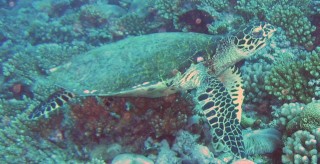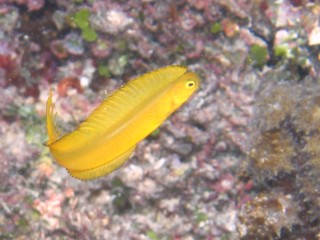
Shot at an angle against the bottom, this fish &
its shadow shows up clearly against the sand
|
Underwater Pages UW Photo Pages |
Composing
by Chris Hacking
Composing an underwater photograph, in terms of background, range, etc. is as important as for a surface photo. However, underwater photography has several characteristics that should be taken into account when composing a picture underwater. Additionally, composing a shot usually means holding position. In the water, that can be quite difficult; the three biggest problems are surge, buoyancy, and current, usually in that order. Light is so scarce at depth that fast shutter speeds are often impractical without a flash, but stabilizing the camera can be tricky.
 Shot at an angle against the bottom, this fish & its shadow shows up clearly against the sand |
Choose your backdrop
The ideal background for an underwater shot depends on the situation, but as
a general rule, avoid cluttered or brightly colored backgrounds. When using ambient
light to photograph an object in the water column (a fish, squid, person...),
the best background is the open water. With a flash, I prefer blah backgrounds
(like a sandy bottom or pale coral) so the subject stands out clearly. Open
water in the background of a flash photograph will often be filled with
backscatter.
Flash photography at close range towards a white sand or rock
bottom should be avoided, as so much light will reflect that the picture will
almost certainly be badly burned out. However, if the target is at least a few
inches off the bottom and the camera is at least 3-5' (.9-1.2m) from the
target, it will often show up very well.
Generally speaking, if there is a specific intended target
(such as a fish, shell, or something similar), it is best to photograph it
against a background that makes the target 'jump out' or draw the eye
immediately. Therefore, if the background is brightly colored and/or highly
textured, it is best to compose the shot so that the target is significantly
closer, brighter, and/or sharper than the background. It also helps if the
target is the dominant object in the picture; it doesn't have to be centered (I
sometimes use the 'entering from stage left' look), but there shouldn't be any
single, clearly defined object that is larger.
 Although a pretty nice shot otherwise, the turtle's front flippers are the only parts that really stand out. Not good! |
Avoid the surge
Surge is the back-and-forth motion caused by waves.
Surge ranges from a barely noticeable gentle rocking to a rapid back-and-forth
flight that can slam a person into rocks or sharp coral, and cause enough
disorientation to induce motion sickness in some people! (I don't dive in this
surge this strong.) In the open water, surge is barely significant; everything
moves together, and surge only slightly impairs swimming (it makes it hard to
build up momentum). However, trying to photograph reef life is very difficult if
there is any surge because the fish will hold position relative to the coral,
while the camera keeps moving back and forth. Sometimes this can be solved by
grabbing a solid piece of rock or dead coral, but in general, photography in
strong surge is extremely difficult.
 Despite the colorful and textured background, this fang blenny stands out clearly because it is much sharper than the wall behind it. |
Feeling too floaty?
Buoyancy is a tricky issue. For
composing a shot, the best solution is to be neutrally buoyant so you neither
float nor sink. However, as most people are naturally at least slightly
positively buoyant (meaning they float), especially when holding a breath and
diving, weights are needed to decrease buoyancy to neutral. Weights can be
dangerous however, as they will make ascents more difficult and can even cause a
person to be negatively buoyant if they pass out underwater (this sometimes
happens to people who have hyperventilated so they can hold their breaths
longer). In this case, chances for survival are very slim.
My preferred compromise for free diving (snorkeling) is to
use weights until I am only slightly buoyant at, say, 10' with a full breath.
Although I will still tend to float slightly, only minimal effort is required to
maintain a steady depth, and less effort is required to dive (giving me more
time to compose my shots). For scuba diving, a buoyancy compensator (BC) device
should always be used to maintain neutral buoyancy.
Go with the flow (or not)
Currents can theoretically carry a
photographer away from his or her intended target, but in truth this is rarely a
problem (except on drift-dives). Light currents can usually be easily overcome
by anybody with fins (flippers). Even somewhat stronger currents that cannot be
overcome for long shouldn't be a problem for the handful of seconds necessary to
take a picture. Really strong currents that cannot be swum against sometimes
occur, especially in localized constrictions such as the passes of atolls. To
hold position and take a picture under these conditions requires holding on to
something solid, such as a rock.
The solution to all situations in which current is trying to
sweep you away is to angle your body up-stream. With the appropriate amount of
swimming exertion, you can hold still relative to the bottom and (hopefully) to
whatever you are trying to photograph. Although this does limit the angles from
which you can work, especially if you are moving with the current such as on a
drift-dive, it is sometimes possible to swim against a current but shoot behind
yourself (down-stream), or at least to one side. Simply turn into the current as
you approach the area you want to photograph, and perhaps move to one side so
you don't have to aim directly behind yourself, then turn your head and aim the
camera while you continue kicking against the current.
Top Level: Home | Destinations | Cruising Info | Underwater | Boat Guests | Ocelot | Sue | Jon | Amanda | Chris | Site Map | Make a Comment
|
If our information is useful, you can help by making a donation |
Copyright © 2000‑ Contact: Jon and Sue Hacking -- HackingFamily.com, svOcelot.com. All rights reserved.